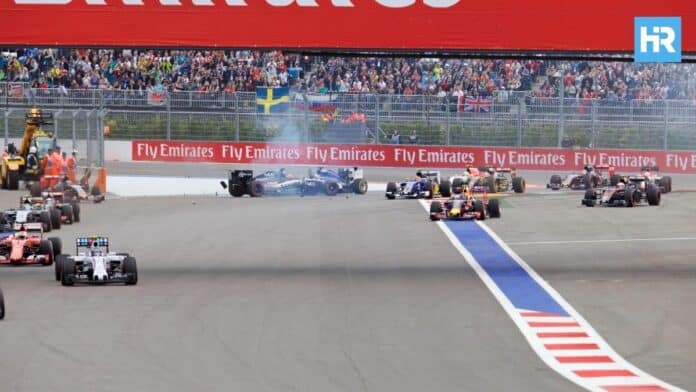Formula 1 has always been about speed, skill, and pushing limits, but sometimes things go horribly wrong.
Over the years, F1 has seen some terrifying crashes that left fans and drivers holding their breath.
As you can imagine, these accidents remind us how dangerous this sport can be, from fiery wrecks to unbelievable flips.
While many of these crashes led to important safety improvements, they’re still some of the most shocking moments in F1 history.
Let’s look at 12 of the most disastrous crashes that had everyone on the edge of their seats.
- Ayrton Senna and Roland Ratzenberger’s tragic deaths at the 1994 San Marino Grand Prix were a wake-up call for F1.
- Crashes like Zhou Guanyu’s in 2022 and Alonso’s in 2016 showed how important the Halo device is. It protects drivers from serious head injuries and keeps them safe during high-speed flips and crashes.
- Modern F1 safety measures, such as strong cockpits, crash structures, and fire-resistant gear, have allowed drivers like Romain Grosjean and Mark Webber to survive horrific crashes that could have been fatal in the past.
1. Ayrton Senna – 1994 San Marino Grand Prix
On May 1, 1994, one of the greatest Formula 1 drivers, Ayrton Senna, sadly died during the San Marino Grand Prix in Imola.
He started the race in first place and was leading when, on lap 7, his car went off the track at the fast Tamburello corner.
He was going about 309 km/h (192 mph) when he lost control, and despite trying to brake, he crashed into a concrete wall at 211 km/h (131 mph).
Then, the front part of his Williams FW16 broke off, and a piece of the car hit him in the head, which caused fatal injuries.
Senna was treated right away by F1’s top doctor, Sid Watkins, but he was unresponsive and had severe head injuries. After that, he was flown to a hospital in Bologna, but he passed away shortly after.
Interestingly, they found an Austrian flag in his car, which he had planned to wave in honor of Roland Ratzenberger, who had died the day before.
Senna’s death led to big changes in F1 safety, including better car designs and improved driver head protection.
2. Roland Ratzenberger – 1994 San Marino Grand Prix
The day before Senna’s crash, on April 30, 1994, Austrian driver Roland Ratzenberger died during the qualifying session.
He had finished a lap when the front wing of his damaged Simtek car broke at high speed.
Ratzenberger crashed into a concrete wall at the Villeneuve corner at around 314 km/h (195 mph) without the downforce needed to keep control. Tragically, the crash caused a skull fracture, killing him instantly.
Ratzenberger’s death marked one of the most tragic F1 deaths and was the first F1 race weekend fatality since 1982.
His accident, along with Senna’s the next day, deeply affected the racing world and led to major improvements in safety, like better crash barriers, advanced medical support, and stronger head protection for drivers.
3. Romain Grosjean – 2020 Bahrain Grand Prix
One of the worst F1 crashes in recent history happened during the first lap of the 2020 Bahrain Grand Prix when Romain Grosjean survived a terrifying accident.
After making contact with Daniil Kvyat’s car at 220 km/h (137 mph), Grosjean’s Haas went off the track and hit a barrier at high speed.
The car split in two, with the front half bursting into flames. Grosjean was stuck in the burning vehicle for 28 seconds but somehow managed to escape, suffering burns to his hands and ankles.
Luckily, the FIA medical team, including Dr. Ian Roberts and Alan van der Merwe, helped pull him over the safety barrier.
During those scary moments, Grosjean said he thought about his kids and remembered Niki Lauda’s fiery crash in 1976. It’s a blessing that thinking about his family gave him the strength to get out.
As a result, this crash led to more investigations by the FIA, focusing on improving barrier designs and using better fire-resistant materials.
4. Niki Lauda – 1976 German Grand Prix (Nürburgring)
Niki Lauda’s 1976 crash at the Nürburgring is one of the most famous accidents in F1 history. During the German Grand Prix, Lauda’s Ferrari spun out and crashed into a barrier, causing the car to catch fire.
Lauda was trapped in the burning wreckage and suffered serious burns to his face while also inhaling harmful fumes.
Other drivers heroically pulled him from the flames, but his injuries were so bad that he was given the last rites at the hospital.
Incredibly, Lauda returned to racing just six weeks later, making a miraculous recovery. His strength and willpower became legendary, and his story was even turned into the 2013 movie Rush.
Following the crash, major changes were implemented in motorsport fire safety and medical response.
5. Zhou Guanyu – 2022 British Grand Prix
During the 2022 British Grand Prix, Zhou Guanyu had a scary crash on the first lap. His Alfa Romeo got hit by George Russell’s Mercedes and Pierre Gasly’s AlphaTauri, flipping his car upside down.
It slid across the track and gravel at high speed, eventually flying over the tire barrier and into the fencing at Silverstone.
Even though the crash was intense, Zhou stayed conscious the whole time, mainly because of the Halo device that protected him from serious injuries.
He was taken out of the car and checked at the medical center, where they confirmed he was fine with no major injuries.
6. Martin Brundle – 1996 Australian Grand Prix
In the 1996 Australian Grand Prix, Martin Brundle had a similar wild crash. At the start of the race, his car crashed into another and flipped, breaking in half when it landed.
Despite how bad it looked, Brundle walked away without getting hurt.
Astonishingly, he ran back to the pits, grabbed the spare car, and restarted the race right after the accident.
Moreover, the crash is remembered for how much damage the car took, with F1’s safety measures credited for keeping Brundle safe.
7. Mark Webber – 2010 European Grand Prix
In the 2010 European Grand Prix in Valencia, Mark Webber had one of the most dramatic crashes in recent F1 history.
After a slow start from second place, Webber was battling with Heikki Kovalainen’s slower Lotus around lap nine.
Webber tried to overtake at high speed but misjudged how quickly Kovalainen was braking.
Following this, Webber’s Red Bull hit the back of the Lotus, launching his car into the air and flipping it before crashing into the tire barriers.
His car hit the track upside down at over 300 km/h, skidded into the barriers, and finally stopped.
Even though it looked terrifying, Webber wasn’t hurt and walked away right after the crash.
This incident really showed how far F1 safety had come, with the car’s cockpit and crash structures protecting Webber.
While the Halo device wasn’t introduced until 2018, this crash highlighted the need for even more safety improvements.
Webber’s crash became a big reminder of how dangerous high-speed racing is, but also how much safety technology has improved to save lives.
Later, Webber said the crash was shocking but that he came out of it without any injuries.
8. Alberto Ascari – 1955 Monaco Grand Prix
Alberto Ascari, one of the best drivers of his time, survived one of the weirdest accidents in F1 at the 1955 Monaco Grand Prix. During the race, Ascari was near the front when, on lap 80, he came into the chicane near the harbor.
He misjudged the corner, and his Lancia D50 went straight off the track and into the Mediterranean Sea.
All witnesses were surprised when Ascari escaped with only minor injuries, even though he had been underwater for several seconds.
Divers and marshals quickly pulled him out of the water. While his car was completely wrecked, Ascari’s survival became legendary, especially given how dangerous F1 was in the 1950s.
This crash is often remembered as one of the strangest in F1 history: the car ended up in the sea, and Ascari escaped what could have been a deadly accident.
Still, the 1955 Monaco crash is one of the most remarkable stories of survival and shows just how unpredictable racing can be.
Sadly, just four days after this accident, Ascari died in a testing crash at Monza, bringing an end to one of the most celebrated careers in F1.
9. 1998 Belgian Grand Prix Pile-Up
The 1998 Belgian Grand Prix at Spa-Francorchamps is known for one of the biggest pile-ups in F1 history. And it all happened just moments after the race started in heavy rain.
As the cars went through the tight La Source hairpin, McLaren’s David Coulthard lost control after hitting a drain cover, causing his car to spin into the barriers and then bounce back onto the track right in front of the other cars.
With the rain making it hard to see, 13 cars got caught up in the crash, with debris and tires flying everywhere.
Drivers like Eddie Irvine, Mika Salo, and Johnny Herbert were among those involved, leading to an immediate halt of the race with a red flag.
Amazingly, even though the crash was huge, none of the drivers were seriously hurt, and most could restart the race after a one-hour delay.
10. Villeneuve and Zonta – 1999 Belgian Grand Prix
During qualifying for the 1999 Belgian Grand Prix, Jacques Villeneuve and his BAR teammate Ricardo Zonta crashed heavily at the famous Eau Rouge corner.
Villeneuve had already tried to take the tricky corner flat out in 1998 and crashed, but in 1999, he gave it another go and lost control again, hitting the barriers hard.
Not wanting to be left behind, Zonta also tried to take Eau Rouge flat out and ended up in a very similar crash right after Villeneuve.
Both drivers walked away without injuries, but their crashes showed just how dangerous and challenging the Eau Rouge corner could be.
11. Fernando Alonso – 2016 Australian Grand Prix
On March 20, 2016, Fernando Alonso had one of the scariest crashes in Formula 1 history during the Australian Grand Prix at Melbourne’s Albert Park.
While fighting for position on lap 19, Alonso tried to overtake Esteban Gutiérrez’s Haas going into Turn 3 at around 240 km/h.
However, Alonso misjudged the gap and clipped the back of Gutiérrez’s car, which sent his McLaren flying.
Alonso’s car flipped multiple times, crashing into the gravel trap and breaking apart, leaving debris all over the track. The crash was so intense that Alonso said later he experienced a 46G impact.
Despite how bad it looked, Alonso walked away from the wreck without major injuries because of the advanced F1 safety features like the Halo and the strong crash structures built into the cars.
After the crash, the race came to a standstill for over 20 minutes to allow for track cleanup. Thankfully, Alonso walked away with minor injuries, like rib pain. He later reflected on his fortunate escape, fully aware of the risks involved in high-speed racing.
The FIA investigated the crash but found neither driver to blame. Alonso’s ability to walk away from such a bad crash proved how much F1 safety has improved.
While he was grateful to continue racing, Alonso did miss the next race in Bahrain because of fractured ribs.
12. Gilles Villeneuve – 1982 Belgian Grand Prix
On May 8, 1982, the world of motorsport was devastated when Gilles Villeneuve, one of F1’s most loved drivers, tragically died during qualifying for the Belgian Grand Prix at Zolder.
Known for his bold and aggressive driving, Villeneuve’s daring style played a part in the crash that took his life.
In his final qualifying attempt, Villeneuve pushed his Ferrari to the limit, trying to beat his teammate Didier Pironi’s time.
As he approached Jochen Mass on a slow lap, Villeneuve tried to pass him at high speed.
Mass moved slightly off the racing line, not expecting Villeneuve to pass so quickly. Then, suddenly, Villeneuve’s car hit the back of Mass’s car, launching his Ferrari into the air.
Villeneuve’s car flipped violently, breaking apart as it tumbled. Tragically, Villeneuve was thrown from the car while still strapped to his seat, landing near the catch fencing.
The injuries were severe, and despite being rushed to the hospital, Villeneuve passed away later that day.
Looking Back: What F1’s Toughest Crashes Teach Us
These 12 crashes are just a glimpse into the wild and dangerous world of Formula 1. While the sport has made great strides in improving safety, these moments remind us how risky it still is when you’re pushing the limits at insane speeds.
Every crash has contributed to making F1 safer, but they also highlight the courage of the drivers who get back in their cars and race again.
If you’re a fan of F1 or just love heart-pounding stories, these crashes show the sport’s intense highs and lows.
Keep watching because you never know what’s going to happen next!






